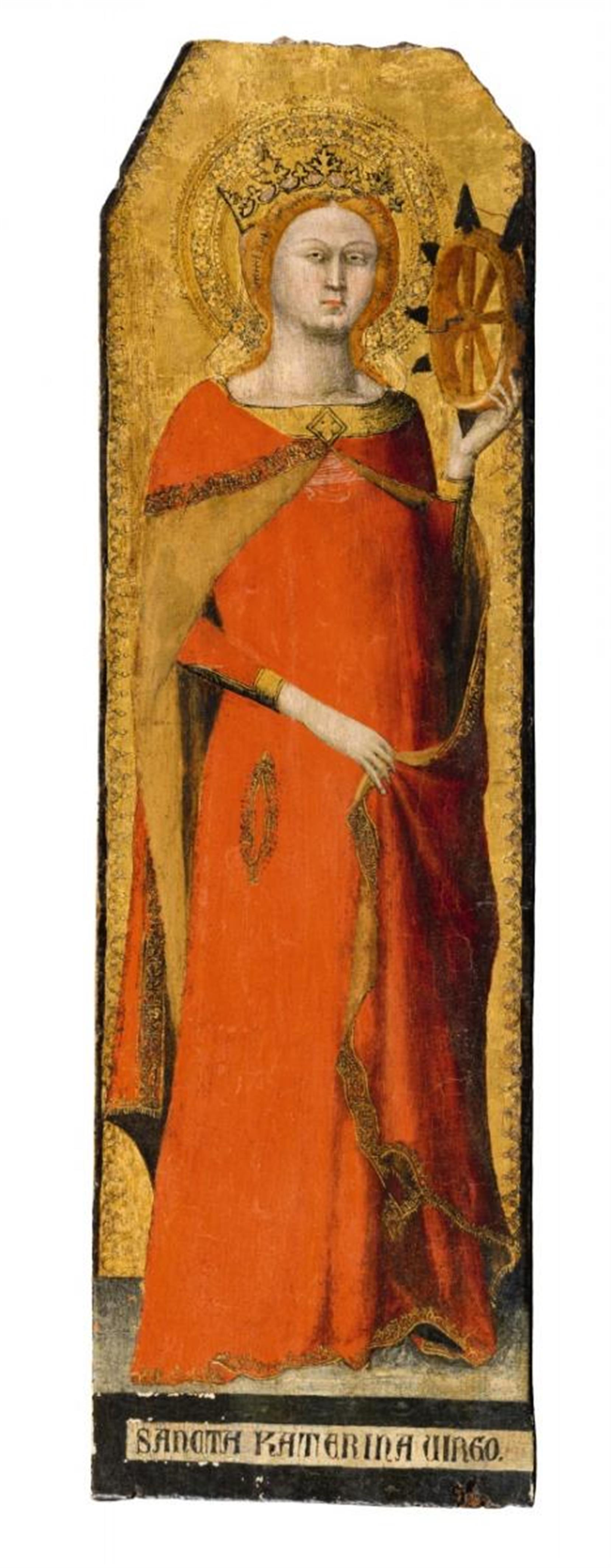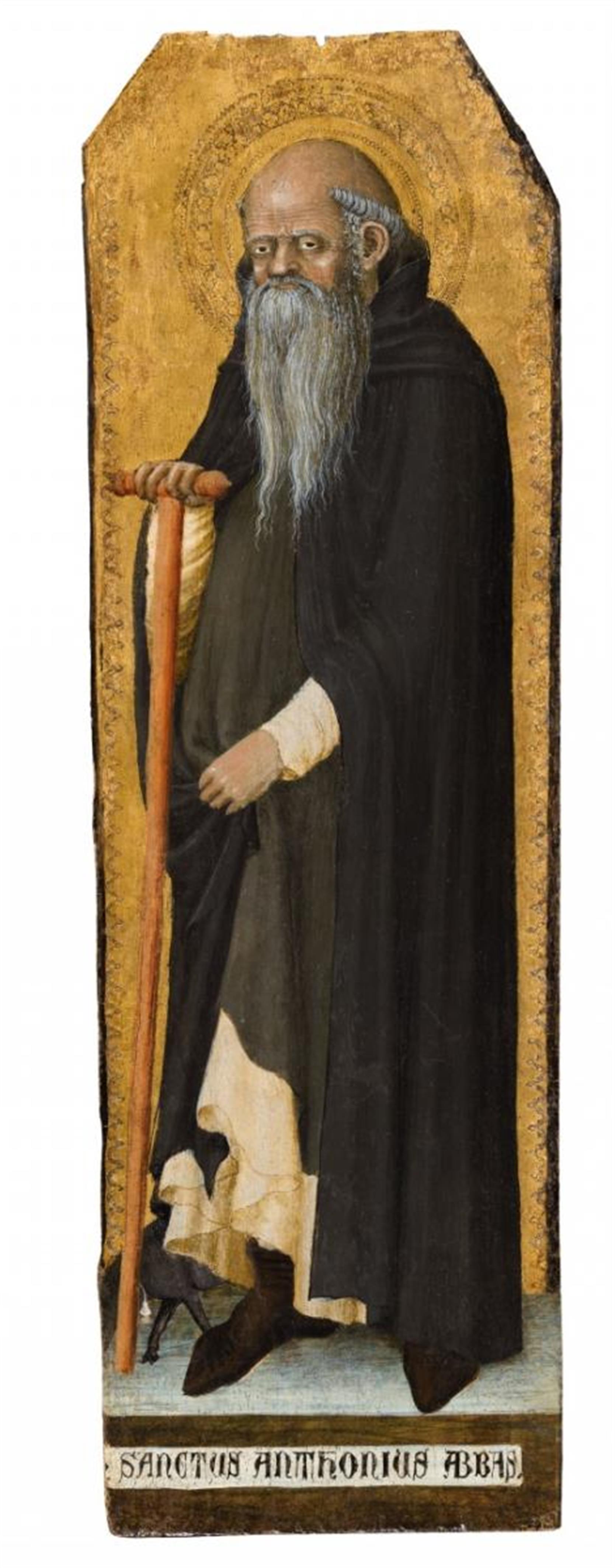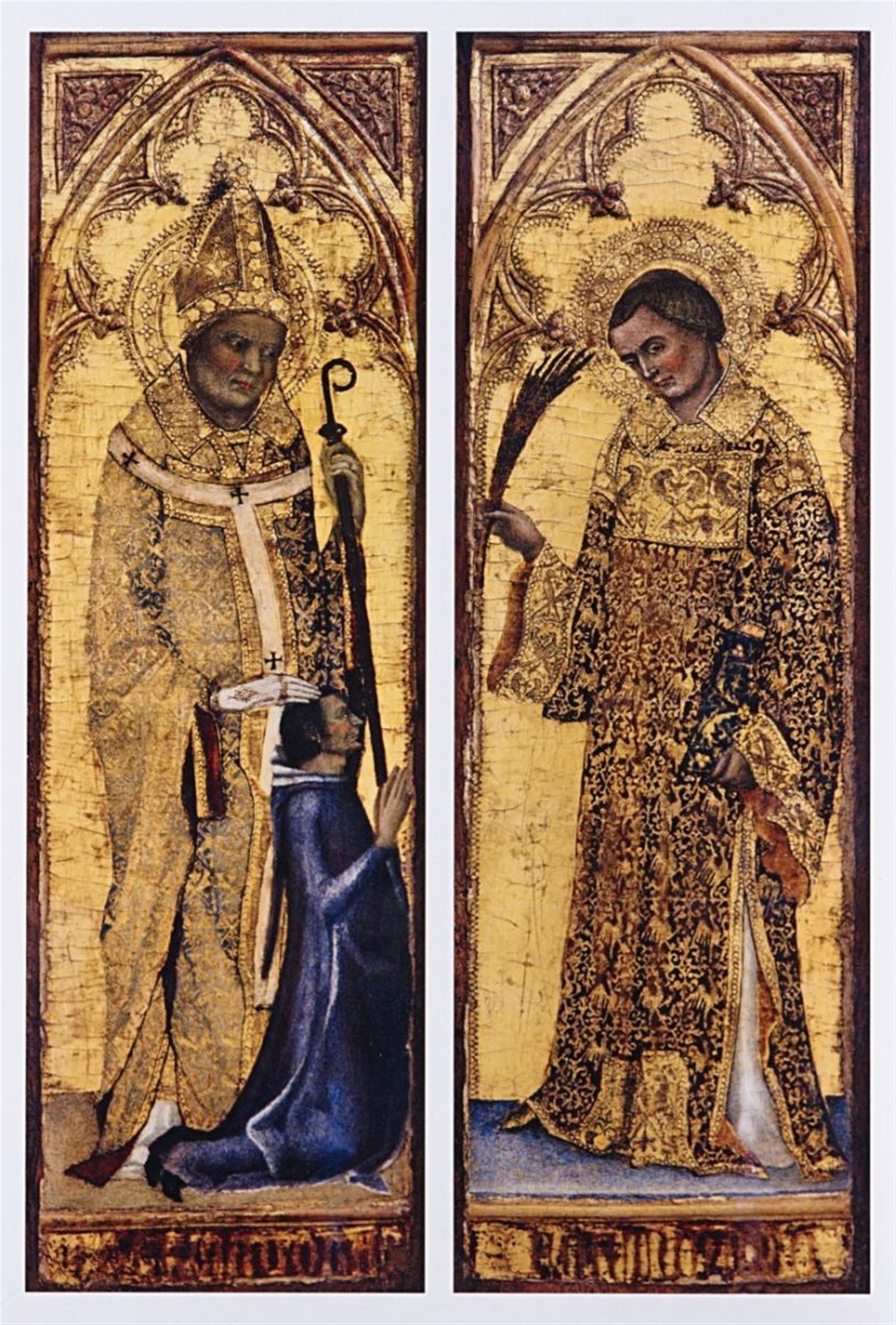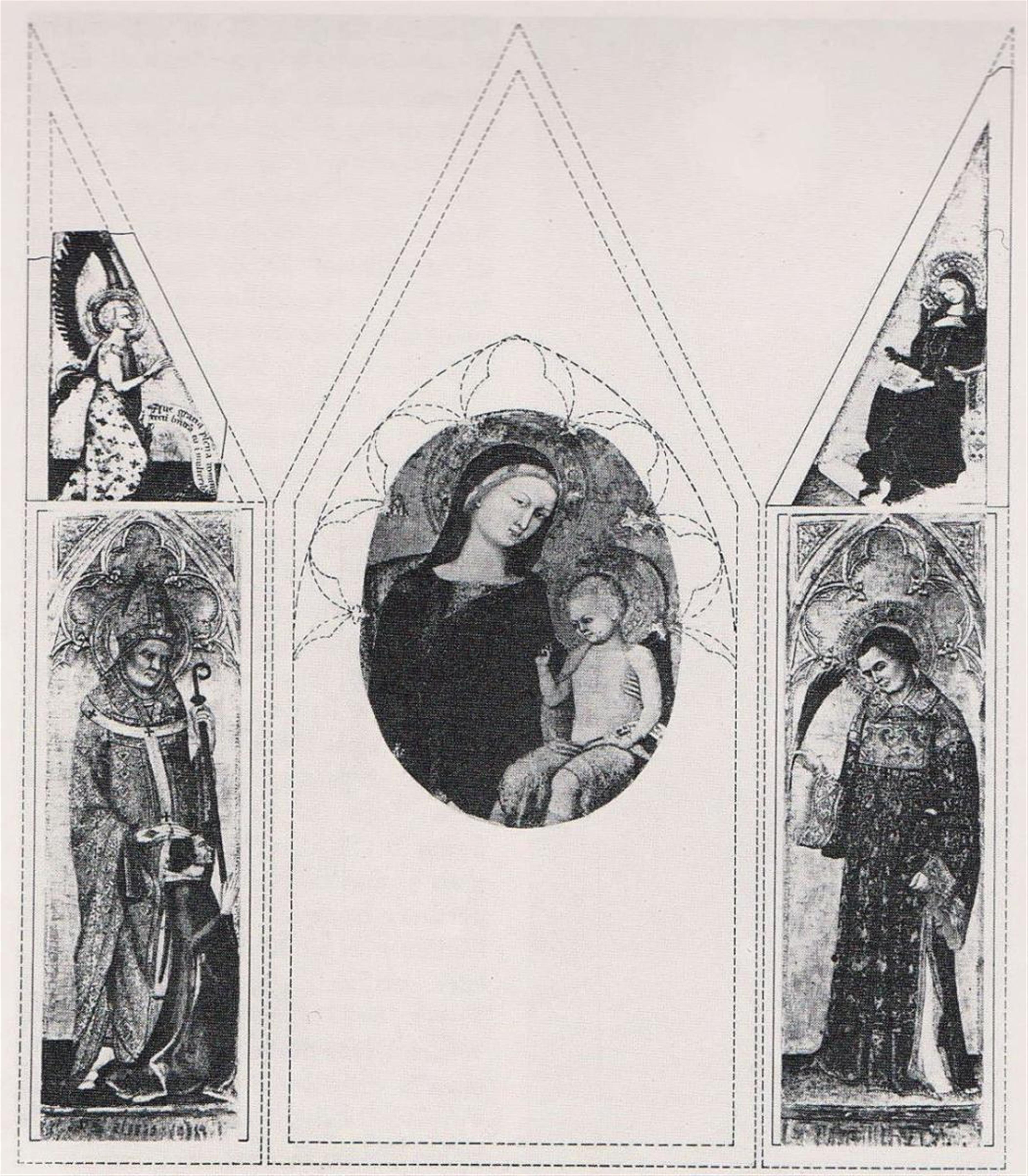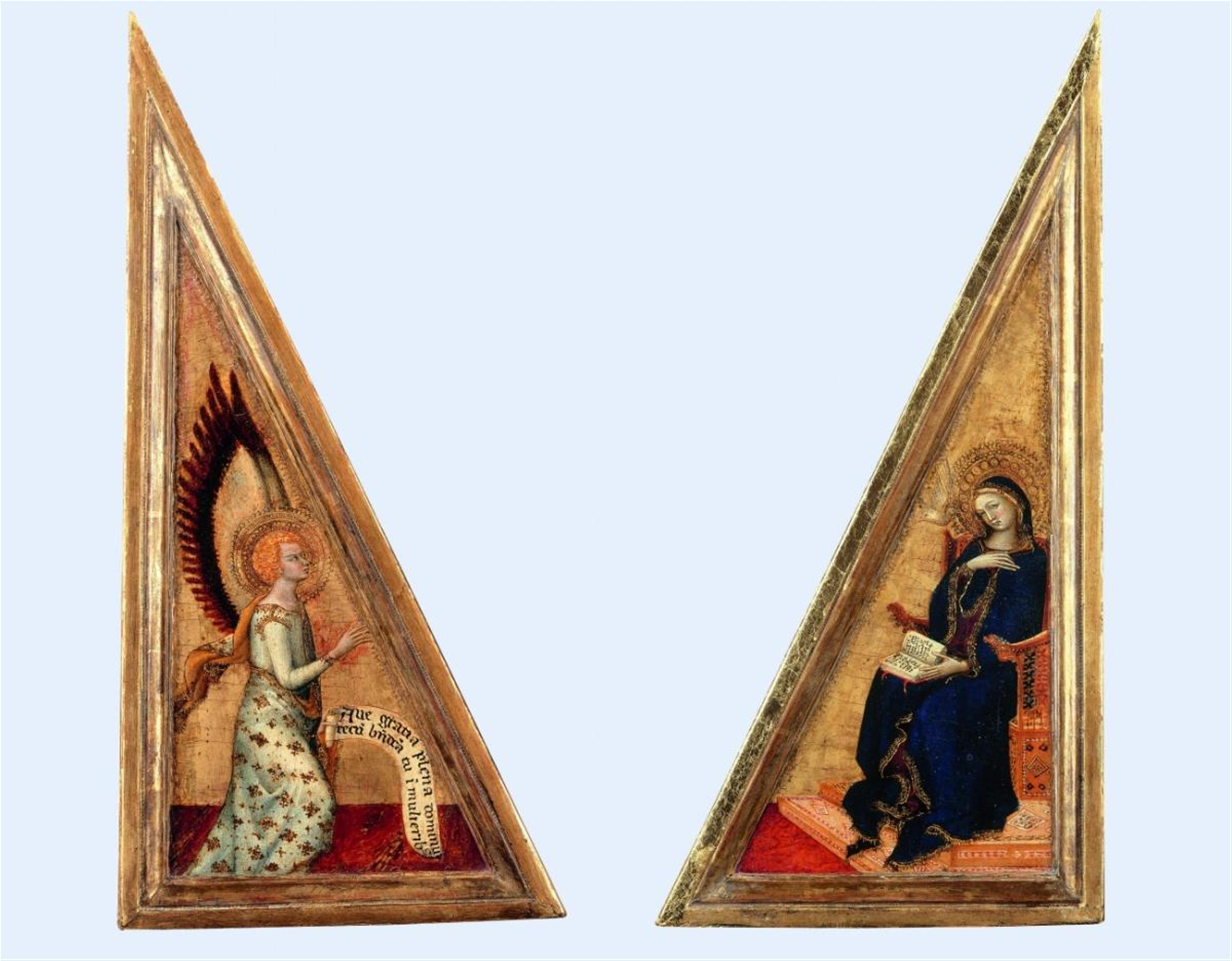Matteo Giovannetti
Catherine of Alexandria and Saint Anthony the Great
Tempera on panel.. Each 64 x 17 cm.
The appearance of two panels by the Italian artist Matteo Giovannetti on the market is an important event for art historical research. A mere handful of works by this painter, who was active in the Papal court at Avignon in the early 14th century, exist today.
The works originate from the estate of the painter Franz von Lenbach, and they are probabely the two works which Raymond de Marle saw in Munich and attributed to Matteo Giovannetti in the early 20th century. The first recorded evidence of the works is a photograph and description in a catalogue for an auction taking place from 24th-31st October 1900, in which they were offered for sale together with other pieces from the collection of Count Cernazai from Udine (Luisa Vertova 1968). It is not known whether Lenbach purchased the panels during this sale or from an art dealer, but upon his death on 6th May 1904 they were certainly part of his impressive art collection and remained in family ownership ever since.
These panels were first published by Luisa Vertova in 1968 and show Saint Catherine of Alexandria as a young princess and Saint Anthony the Great as a hermit. The attribution to the enigmatic painter from Viterbo is based upon careful comparison of the panels with Giovannetti's frecoes in the “Palais des Papes” in Avignon, but also with his few surviving panel paintings. The stylistic similarities found were further supported by comparison with workshop details such as the embossed ornaments of the haloes, the patterns of which were made with the same tools as those of other panels by this artist, such as the ornaments in two paintings of the Saints Hermagoras and Fortunatus in the Museo Correr in Venice (illus. 1).
Two further works by Giovannetti from the Cernazai collection were sold in the 1900 auction: Two gable ornaments depicting the annunciation which are now kept in the Louvre in Paris (illus. 2) and an oval panel of the Virgin and Child in private ownership in Paris (illus. 3). Today we assume that all three works were originally part of the same altarpiece which was previously owned by the Manin family in Venice. It is exceedingly probable that Teodoro Correr purchased the two panels of Saints now kept in the Museo Correr from the Manin family in the early 19th century (A. Lenza 2014).
The Saints Hermagoras and Fortunatus are the patron saints of the town of Aquileia, which provides an interesting clue as to the patron of Giovannetti's altarpiece. Bertrando de Saint Geniés, the papal Chaplain in Avignon, was appointed Patriarch of Aquileia in 1334. His later custodian in Avignon was Manino II Manin, who also originated from the northern town of Veneto and was most probably the donor of the altarpiece. This assumption is heavily supported by the fact that the work is known to have been in the possession of the renowned Manin family, to whom the last Doge of Venice also belonged, until the late 18th century. When closed, the altarpiece would have measured 92 x 40 cm and displayed the two present panels with Saint Catherine to the left and Saint Anthony to the right. The Virgin and Child would have formed the central panel, flanked by Saints Hermagoras and Fortunatus and crowned by the two arched panels in Paris (illus. 3).
Matteo Giovannetti was probably born in Viterbo in circa 1300. He is mentioned in papal correspondence in 1322 and again in 1328. His artistic career probably centred around Avignon, where he is mentioned as court painter to the Pope as of 1343, probably succeeding the Sienna artist Simone Martini who died in 1344. In Avignon he painted the frescoes in the Chapel of Saint Martial (1344 - 46) and the Chapel of Saint Michael for Pope Clemens VI. Later he painted the frescoes in the Chapel of Saint John (1346 - 48) and the prophets in the audience hall (1353) of Clemens' successor Innozenz VI. The frescoes in the Chapel of Chartreuse in Villeneuve-les-Avignon also originate from this time period. However, very little has survived of Giovannetti's numerous works on panel. Aside from the above-mentioned pieces from the altarpiece of Manino II Manin, we also know of a Madonna in the Chalandon collection in Parcieux and a Crucifixion in the collection of the Cassa di Risparmio in Viterbo. Researchers agree that the panels from this small, reconstructed altarpiece belong to Giovannetti's early phase of around 1344-46, as many stylistic parallels exist between these works and the frescoes of the Chapel of Saint Martial.
The elegant style of Simone Martini must have been an important inspiration for Giovannetti's artistic development in Avignon. This is evident in the Madonna of the Annunciation kept in the Louvre, which is clearly influenced by Simone's small Orsini altarpiece (Antwerp, Koninklijk Museum voor Schone Kunsten). Giovannetti's work is characterised by a keen observation of nature, which is especially evident in the features of the donor in the Correr-panel, as well as those of the elderly Saint Anthony and the graceful figure of Saint Catherine of Alexandria, whose delicate veil is draped over her hair and folded beneath her red cloak. His exceptionally modern interest in the human form inspired him to paint figures, gestures and physiognomies unparalleled in the art of his time.
Giovannetti was only able to develop this unique style in dialog with the artistic culture of Avignon. The international climate in the Southern French papal Court was what allowed him to become the most original painter not only in Italy, but the whole of Europe at the time, encorporating elements common to the International Gothic style of the early 15th century. Both the present two panels and the corresponding works from the Manin altarpiece represent exceedingly rare testimonies to his artistic talent.
We would like to thank Professor Gaudenz Freuler for his academic support in researching this piece and for his comprehensive expertise.
Fig. 1: St. Hermagoras and St. Fortunatus, Museo Correr, Venice (Photo Fondazione Musei Civici Venezia)
Fig. 2: The Annunciation, Musée du Louvre, Paris (Photo bpk / RMN - Grand Palais / Daniel Arnaudet)
Fig. 3: Reconstruction of the altarpiece (Photo Gutachten Prof. Gaudenz Freuler)
Certificate
Prof. Dr. Gaudenz Freuler, Zurich 2014.
Provenance
18th C., Galleria Manin, Venice. - The Jacopo Danieli collection, Padua. - Museum Danieli, Zadar. - The Count Cernazai collection, Udine 1859. - The Franz von Lenbach collection, Munich 1900. - After his death henceforth in family ownership from 1904 to the present day.
Literature
R. van Marle: The Development of the Italian Schools of Painting, II, The Hague 1924, p. 317. - L. Vertova: Testimonianze frammentarie di Matteo da Viterbo, in: Festschrift für Ulrich Middeldorf, Berlin 1968, p. 45-51. - M. Laclotte / D. Thiébaud: L´'École d´Avignon, Paris 1983, p. 32-48, 166-169. - D. Thiébaud: Matteo Giovannetti, in :L`Art gothique siennois, Katalog Avignon 1983, p. 189-190. - E. Castelnuovo: Un pittore Italiano alla corte di Avignone. Matteo Giovannetti e la Pittura in Provenza nel secolo XIV, Torino (2nd edition) p. 95, footnote. 5.

